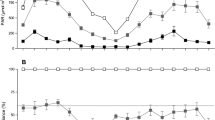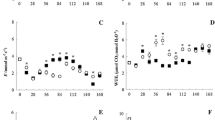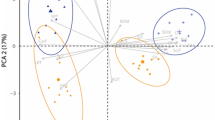Summary
Seedlings of shade-intolerant species react to alterations of the light climate caused by their neighbors with morphological changes that may influence the pattern of resource acquisition and utilization at the whole-canopy level. One such change, the increased stem elongation rate that is triggered by low red (R, 660 nm) to far-red (FR, 730 nm) ratios (R:FR) in dense canopies, might reduce the amount of assimilates available for leaf area expansion or root growth, and in that way affect resource capture by the canopy. We have tested this hypothesis by comparing the growth of both isolated individuals and canopies of the weed Amaranthus quitensis under conditions differing only in the spectral distribution of the incident light. When canopies received the full spectrum of sunlight, the stems were a large proportion (40–57%) of total biomass. Filtering the FR waveband (and hence raising the R:FR ratio to eliminate the neighbors' proximity-signal) resulted in shorter canopies with lighter stems. However, the growth of leaves and roots was not promoted by this treatment, indicating that the opportunity cost of the assimilates invested in the stems was nil or very small. Filtering the FR had no effect on biomass accumulation when plants were grown as isolated individuals. The higher growth of the canopics under full spectrum could be due to a higher light interception or to a higher efficiency of light conversion into biomass. The first possibility is weakened by the observation that filtering the FR had no effect on the dynamics of soil covering by the crops. The second is indirectly strengthened by results of an experiment with isolated plants showing that stem elongation, stem growth, and total plant biomass can be increased by reducing the flux of R light received by the stems without affecting the light climate of the leaves. Further work is needed to distinguish between these two possibilities; whatever the cause, our results show that the elongation responses to decreased R:FR may lead to a net increase in canopy productivity, and do not necessarily have a negative impact on the growth of resource-harvesting organs.
Similar content being viewed by others
References
Ballaré CL, Sánchez RA, Scopel AL, Casal JJ, Ghersa CM (1987) Early detection of neighbour plants by phytochrome perception of spectral changes in reflected sunlight. Plant Cell Environ 10:551–557
Ballaré CL, Sánchez RA, Scopel AL, Ghersa CM (1988) Morphological responses of Datura ferox seedlings to the presence of neighbours. Their relationships with canopy microclimate. Oecologia 76:288–293
Ballaré CL, Scopel AL, Sánchez RA (1989) Photomodulation of axis extension in sparse canopies. Role of the stem in the perception of light-quality signals of stand density. Plant Physiol 89:1324–1330
Ballaré CL, Scopel AL, Sánchez RA (1990) Far-red radiation reflected from adjacent leaves: An early signal of competition in plant canopies. Science 247:329–332
Ballaré CL, Scopel AL, Sánchez RA (1991) Photocontrol of stem elongation in plant neighbourhoods. Effects of photon fluence rate under natural conditions of radiation. Plant Cell Environ 14 (in press)
Baeumer K, De Wit CT (1968) Competitive interference of plant species in monocultures and mixed stands. Neth J Agric Sci 16:103–122
Cabrera AL, Zardini EM (1978) Manual de la Flora de los Alrededores de Buenos Aires, 2nd Edition, Acme, Buenos Aires, 755 pp
Casal JJ, Smith H (1989) The function, action and adaptive significance of phytochrome in light-grown plants. Plant Cell Environ 12:855–862
Deregibus VA, Sánchez RA, Casal JJ, Trlica MJ (1985) Tillering responses to enrichment of red light beneath the canopy in a humid natural grassland. J Appl Ecol 22:199–206
Evans JR (1987) The dependence of quantum yield on wavelength and growth irradiance. Aust J Plant Physiol 14:69–79
Geiger DR (1976) Effects of translocation and assimilate demand on photosynthesis. Can J Bot 54:2337–2345
Gifford RM, Evans LT (1981) Photosynthesis, carbon partitioning, and yield. Annu Rev Plant Physiol 32:485–509
Green CF, Valdyanathan LV (1986) A reappraisal of biomass accumulation by temperate cereals. Spec Sci Technol 9:193–212
Grime JP, Jeffrey DW (1965) Seedling establishment in vertical gradients of sunlight. J Ecol 53:621–642
Hampson SE, Loomis SR, Rains DW (1978) Regulation of sugar uptake in hypocotyls of cotton. Plant Physiol 62:851–855
Heindl JC, Brun WA (1983) Light and shade effects on abscission and 14C-photoassimilate partitioning among reproductive structures in soybean. Plant Physiol 73:434–439
Hoddinott J, Hall LM (1982) The responses of photosynthesis and translocation rates to changes in the Z ratio of light. Can J Bot 60:1285–1291
Holmes MG, Sager JC, Kein WH (1986) Sensitivity to far-red radiation in stomata of Paseolus vulgaris L.: Rhythmic effects on conductance and photosynthesis. Planta 168:516–522
Humphries EC (1963) Effects of (2 chloro-ethyl) trimethylammonium chloride on plant growth, leaf area, and net assimilation rate. Ann Bot 27:517–532
Hurlbert SH (1984) Pseudoreplication and the design of ecological field experiments. Ecol Monogr 54:187–211
Inada K (1976) Action spectra for photosynthesis in higher plants. Plant Cell Physiol 17:355–365
Kasperbauer MJ, Peaslee DE (1973) Morphology and photosynthetic efficiency of tobacco leaves that received red or far red light during development. Plant Physiol 52:440–442
Lecharny A (1985) Phytochrome and green plants. Physiol Vég 23:963–982
McCree KJ (1972) The action spectrum, absorptance and quantum yield of photosynthesis in crop plants. Agric Meteorol 9:191–216
Mor Y, Halevy AH (1980) Promotion of sink activity of developing rose shoots by light. Plant Physiol 66:696–1000
Morgan DC, O'Brien T, Smith H (1980) Rapid photomodulation of stem extension in light-grown Sinapis alba L. Studies on kinetics, site of perception and photoreceptor. Planta 150:95–101
Myers RL, Brun WA, Breimer ML (1987) Effect of racemelocalized supplemental light on soybean reproductive abscission. Crop Sci 27:273–277
Neales TF, Incoll LD (1968) The control of leaf photosynthesis by the level of assimilate concentration in the leaf: A review of the hypothesis. Bot Rev 34:107–125
Novoplansky A, Cohen D, Sachs T (1990) How portulaca seedlings avoid their neighbours. Oecologia 82:490–493
Reekie EG, Bazzaz FA (1987) Reproductive effort in plants. I. Carbon allocation to reproduction. Am Nat 129:876–896
Schmalstig JD, Cosgrove DJ (1989) Phloem unloading and cell expansion in pea stems. Plant Physiol 89 (Suppl): 31
Smith H (1981) Adaptation to shade. In: Johnson CB (ed) Physiological Processes Limiting Plant Productivity. Butterworths, London, pp 159–173
Smith H (1982) Light quality photoperception, and plant strategy. Annu Rev Plant Physiol 33:481–518
Smith H (1986) The perception of light quality. In: Kendrick RE, Kronenberg GHM (eds) Photomorphogenesis in Plants. Marthinus Nihoff Publishers, Dordrecht, pp 187–217
Thompson L, Harper JL (1988) The effect of grasses on the quality of transmitted radiation and its influence on growth of white clover Trifolium repens. Oecologia 75:343–347
Tilman D (1988) Plant Strategies and the Dynamics and Structure of Plant Communities. Princeton Univ. Press, Princeton, NJ
Warrington IJ, Rook DA, Morgan DC, Turnbull HL (1988) The influence of shadelight and daylight on growth, development and photosynthesis of Pinus radiata, Agatis australis and Dacrydium cupressinum. Plant Cell Environ 11:343–356
Author information
Authors and Affiliations
Rights and permissions
About this article
Cite this article
Ballaré, C.L., Scopel, A.L. & Sánchez, R.A. On the opportunity cost of the photosynthate invested in stem elongation reactions mediated by phytochrome. Oecologia 86, 561–567 (1991). https://doi.org/10.1007/BF00318323
Received:
Accepted:
Issue Date:
DOI: https://doi.org/10.1007/BF00318323




